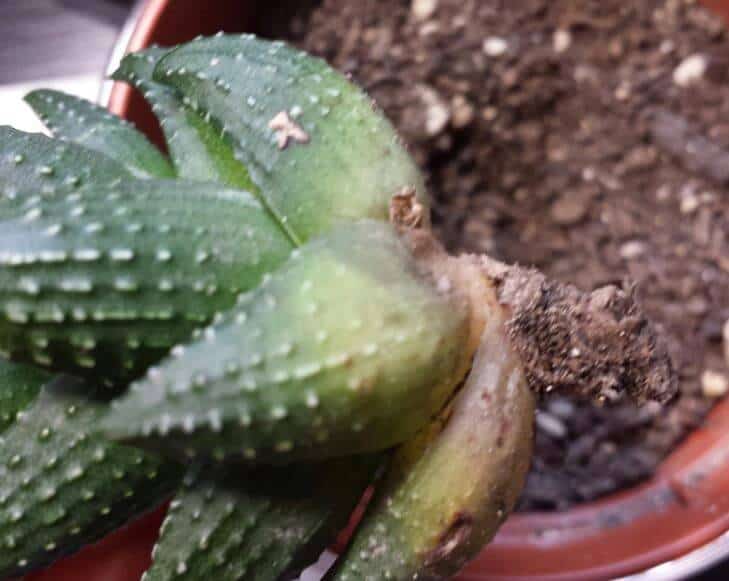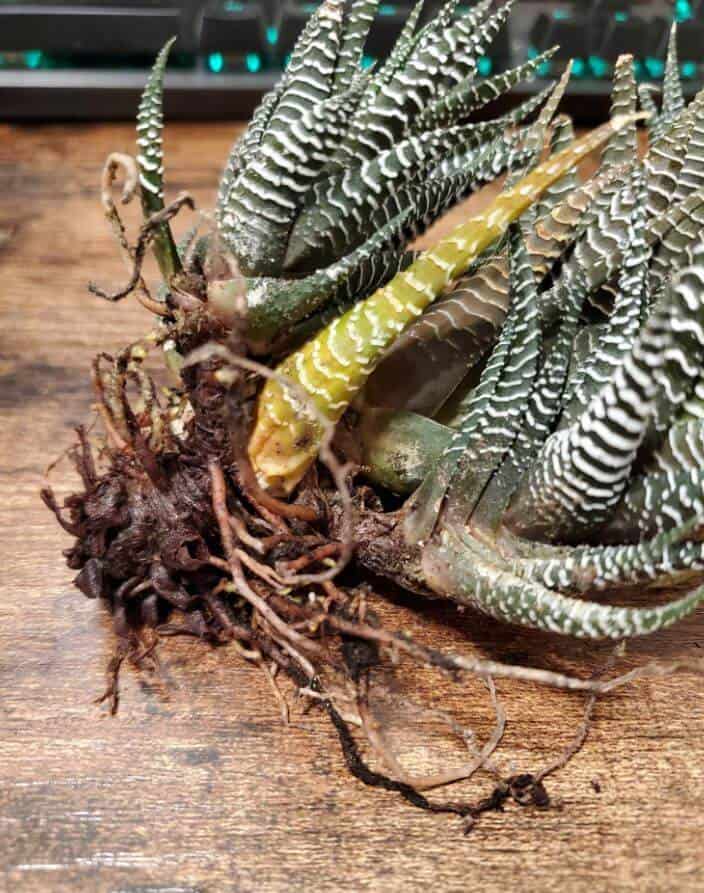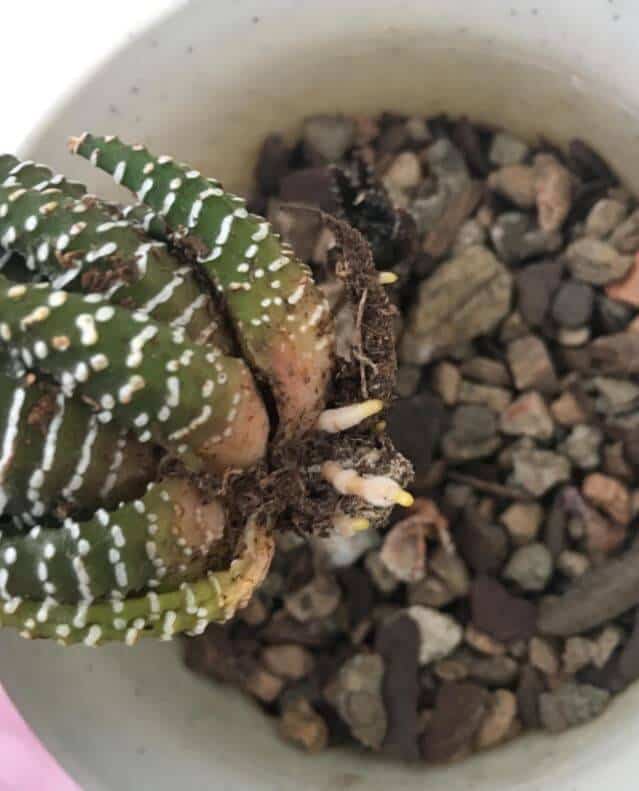Last Updated on July 3, 2023 by a Friendly Gardener
Haworthia are lovely succulents that require very little in terms of care. As South African natives, they are quite accustomed to living and thriving in extreme temperatures.
One of the most common diseases to afflict Haworthias is root rot. They are particularly susceptible because their root systems are particularly fleshy. Unfortunately, when root rot attacks, it often will not stop at the roots and will continue to rot both stems and foliage. In warm climates or high temperatures, it can be fatal to Haworthia plants in a very short time, even a couple of hours.
Generally, Haworthia root rot is due to excessive water retention in the soil bed or growing medium. Other reasons include pest infestations. Mealybugs can attack, and wound roots. A festering wound will eventually rot. Root rot may manifest its presence through the rotting of foliage or leaf drop. These plants when ill can also lose roots because the root system is unable to anchor to the soil bed. Root shedding should not be confused with root rot. Old roots turn hollow before shedding.
Identifying Haworthia Root Rot

Watering a Haworthia plant too often is a common cause of root rot. Leaves may begin to pale, turn yellow and feel soft or soggy to the touch and wilt. These are common symptoms of Haworthia root rot. When these appear. It’s best to remove your plant from the soil bed and inspect root systems. Infected roots will appear brown, black, or dark and require urgent treatment if you hope to save your plant.
Haworthia Root Rot Causes

Root rot is a potentially lethal disease. If a plant is overrun with the infection, it is almost impossible to save it. Common causes of root rot in Haworthia are:
-
Overwatering
Overwatering Haworthia is the principal cause of root rot in these plants. When watering is excessive the soil will become soggy with exaggerated water retention and create the perfect environment for the fungus to develop and attack.
-
Poor Soil Blend

Poor quality soil or soil that is not well-draining is another serious problem for Haworthias. Succulents should be planted in soil mixes that are fast-draining and that guarantee soil and root aeration. Ideally, succulents like Haworthias should be planted in soil specially formulated for cacti and succulents. No type of succulent wants to be left sitting in water or waterlogged soil.
-
Pest Infestations
Pests, such as mealybugs, will occasionally attack Haworthia roots and feed on them and this will cause roots to rot. Fungi in the soil can also attack root balls and cause them to begin rotting.
How to Save Haworthia from Root Rot
There are several ways to save your Haworthia plant from root rot. Consider these methods if your plant has been infected.
Drying Haworthia Roots

To begin, the Haworthia plant needs to be removed from the growing medium or soil bed. Then set your plant aside to permit the roots to dry out completely. This may take a few days, after which you will need to examine the affected roots to verify if the rotting has been interrupted. Examine the roots to verify that they are no longer dark in color and are returning to a healthier pale hue. In this case, the plant can be repotted in a fresh growing medium.
This method can be exceptionally effective if the infection is limited to the roots. If foliage and stems are already infected, this method will not work.
Pruning Infected Roots

Trimming off infected roots is a standard means of treating root rot in any number of houseplants. It is highly effective in curing root rot and saving affected plants.
Begin by removing the Haworthia plant from the soil bed and then remove the soil attached to the root ball gently. Examine roots closely for dark spots on roots which may appear brown or black in hue. Roots with dark spots are infected and will need to be removed. Using sterile shears, scissors, or a garden knife, slice and remove rotted roots. Your cutting tool must be sterilized to prevent the spreading of the infection of the plant from the roots. Slice off infected roots and stems at least an inch above where the infection manifests itself. Now leave the Haworthia roots in the open air to callous for a couple of days before you repot them in a fresh growing medium. Make sure your new soil mix is well-draining.
Treating Infected Roots with Sulfur
Sulfur treatments are often used by experienced gardeners to contrast root rot. Root rot is a fungal infection and sulfur is dusted onto infected roots to kill fungal spores. Sulfur will also aid in acidifying soil so that funguses cannot form. Unfortunately, if root rot is due to overwatering, this method is not particularly effective. In the case of root rot due to overwatering, trimming infected roots will probably be your best option.
Preventing Haworthia Root Rot
Although Haworthias are quite easy to cultivate, they are very difficult to treat if root rot sets in. Prevention is, indeed, the best medicine. To prevent root rot from attacking your Haworthia plant, follow these easy recommendations.
-
Choose well-draining soil
Good quality, well-draining soil is an essential factor for a thriving succulent. Ideally, water should drain away, and the growing medium should retain just enough moisture for the plant’s needs and no more.
-
Perfect Your Watering Schedule
Haworthias require very little watering. They can thrive for weeks without watering. Use the soak method where you do a deep watering when the soil bed has dried out completely. Poke the soil with a finger to test for dampness. Generally, succulents do not require watering more than once per week.
-
Choose a Pot with Drainage Holes
Pots with drainage holes aid the soil in draining excess water and help the soil to dry faster. They are an essential tool in contrasting overwatering.
-
Provide Proper Lighting
Haworthias are desert natives, so they require a generous amount of light exposure to thrive. Your plant should have several hours of direct sunlight daily.
-
Feed for a Nutrient Boost
Feed your Haworthia once monthly with a succulent fertilizer to provide a nutrient boost. Dried or pale foliage can be indicative of a nutrient deficiency.
A Final Thought
When dealing with root rot, it’s important to catch it early and to intervene rapidly. Pruning diseased roots is often your best course of action, should this infection strike.

